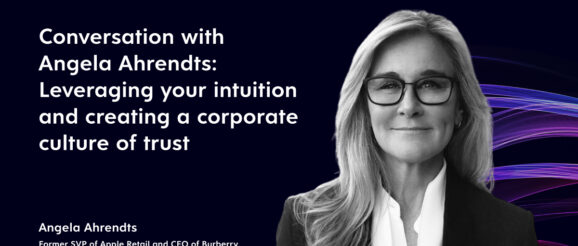Former Apple and Burberry executive Angela Ahrendts on how workforce trust breeds innovation

Angela Ahrendts’ tenure in the retail industry is both extensive and impressive: her most notable experience being her two most recent positions as CEO of Burberry (2006-2014), and SVP of Retail at Apple Inc. (2014-2019). At Burberry, she doubled revenues, and helped the company embrace ecommerce and update in-store technology. At Apple, she was tasked with reimagining the store experience while also enhancing employee engagement. She redefined the shopping experience for millions of customers around the world, and simultaneously improved the employee experience for all she worked with.
Ahrendts’ leadership experience is invaluable, and she has a breadth of knowledge when it comes to ensuring retailers stay relevant and thrive in the new world of work. Particularly, Ahrendts firmly believes that an amazing corporate culture and employee experience creates quantifiable value for organizations.
Here are four takeaways from her session for building a culture that drives value and inspires people in today’s world of work.
WATCH ON-DEMAND: Conversation with Angela Ahrendts: Leveraging your intuition and creating a corporate culture of trust
Corporate culture starts with foundational trust
Ahrendts called herself a culture guru, which is one of the ways she translates her leadership experiences into lessons for the future of work. Reflecting on her time at Burberry, she attributed the company’s success largely to its corporate culture. She reinforced how instilling trust in the workforce unlocks creativity and breeds success, creating an amazing energy and momentum. Culture unites employees and inspires productivity.
“It’s important to build a trusting environment. When people feel they belong, their minds open up, and creativity and innovation are unlocked. An organization becomes a collective who can do ‘more’. This enables employees to do their best life’s work,” Ahrendts said.
She pointed out that oftentimes leaders don’t fully treat culture as a pillar that drives business value:
“I don’t think culture is always understood in business. Culture is really just building a foundation that is trusting, that frames the values and the beliefs of a company. When you unite and create a connected culture, it’s not about an individual – it’s about greater good.”
A creative culture breeds innovation
According to Ahrendts, if your organization isn’t innovative, it will not stand up against the competition. To be successful and to actually be known as successful, you have to constantly innovate. And to truly unlock innovation, leaders need to leverage the creative brain power and trust of the entire workforce. Innovation and creativity are as much a function of a work environment as it is a personal trait.
“A closely connected culture unlocks creative thinking which unlocks innovation. If you are not an innovative company, you would be lucky to get by fine – but you won’t overcome the competition.”
The future workforce will thrive off freedom
The current fluid nature of work (more employees working from home, making their own hours) reinforces how instilling trust and freedom into your workforce promotes productivity. Ahrendts said that to truly enable freedom in your workforce and to encourage employees to have a voice, employees need to have accessible technology. By doing this, the workforce will have the confidence and freedom to make their work life truly work for them, on their terms. The future of work is fluid, after all.
“The freedom to work whenever, wherever – freedom to use their instincts and intellect. Employees of the future want their freedom to be more emotionally vested and connected to their work.
Ahrendts backed this up by underscoring the importance of giving your workforce the freedom to explore how they can give back to their communities through volunteering. This ultimately enables employees to discover what’s important to them in a larger context.
“Everyone feels this huge calling with everything we’ve gone through – allowing employees the freedom to volunteer and to donate their time and help their communities is imperative.”
Remove workforce barriers and flatten your organization
To effectively instill trust, freedom, and open communication, Ahrendts said organizations need to focus on less hierarchy and bureaucracy, and more on removing barriers by flattening the organization. The most transformational ideas, she said, come from the collective brain power of the workforce, not individuals; encourage employees to share their ideas and the best leaders will be able to help bring them to life.
“We have to flatten our organizations,” Ahrendts said. “Companies will be hugely transformed. And they have to leverage technology to stay on top of it successfully.”
Ahrendts reinforced that leaders who focus on driving innovation and building trust through the employee experience will realize long-term benefits when it comes to their people driving value.
“The sooner we can break down barriers, the sooner we can free up creative thinking from every individual, and they can do their life’s great work.”
